Cadbury
Cadbury, formerly Cadbury's and Cadbury Schweppes, is a British multinational confectionery company wholly owned by Mondelez International (originally Kraft Foods) since 2010. It is the second largest confectionery brand in the world after Mars.[2] Cadbury is internationally headquartered in Uxbridge, west London, and operates in more than 50 countries worldwide. It is known for its Dairy Milk chocolate, the Creme Egg and Roses selection box, and many other confectionery products. One of the best-known British brands, in 2013 The Daily Telegraph named Cadbury among Britain's most successful exports.[3]
 | |
| Subsidiary | |
| ISIN | GB00B2PF6M70 |
| Industry | Confectionery |
| Founded | 1824 in Birmingham, Warwickshire, England |
| Founder | John Cadbury |
| Headquarters | Uxbridge, London, England |
Key people | Irene Rosenfeld, (Chairman) Dirk Van de Put, (CEO) |
| Products | See list of Cadbury products |
Number of employees | 71,657 (2008)[1] |
| Parent | Mondelez International |
| Website | www |
Cadbury was established in Birmingham, England in 1824, by John Cadbury who sold tea, coffee and drinking chocolate. Cadbury developed the business with his brother Benjamin, followed by his sons Richard and George. George developed the Bournville estate, a model village designed to give the company's workers improved living conditions. Dairy Milk chocolate, introduced in 1905, used a higher proportion of milk within the recipe compared with rival products. By 1914, the chocolate was the company's best-selling product. Cadbury, alongside Rowntree's and Fry's, were the big three British confectionery manufacturers throughout much of the 19th and 20th centuries.[4]
Cadbury was granted its first Royal Warrant from Queen Victoria in 1854. It has been a holder of a Royal Warrant from Elizabeth II since 1955.[5] Cadbury merged with J. S. Fry & Sons in 1919, and Schweppes in 1969, known as Cadbury Schweppes until 2008, when the American beverage business was split as Dr Pepper Snapple Group; the rights ownership of the Schweppes brand had already differed between various countries since 2006. Cadbury was a constant constituent of the FTSE 100 on the London Stock Exchange from the index's 1984 inception until the company was bought by Kraft Foods in 2010.[6][7]
History
1800–1900: Early history
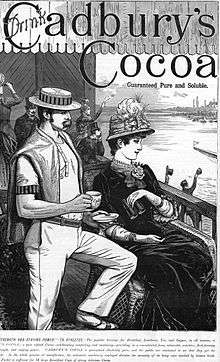
In 1824, John Cadbury, a Quaker, began selling tea, coffee or drinking chocolate in Bull Street in Birmingham, England.[8][9] From 1831 he moved into the production of a variety of cocoa and drinking chocolates, made in a factory in Bridge Street and sold mainly to the wealthy because of the high cost of production.[10] In 1847, John Cadbury became a partner with his brother Benjamin and the company became known as "Cadbury Brothers".[10] In 1847, Cadbury's competitor Fry's of Bristol produced the first chocolate bar (which would be mass-produced as Fry's Chocolate Cream in 1866).[11] Cadbury introduced his brand of the chocolate bar in 1849, and that same year, Cadbury and Fry's chocolate bars were displayed publicly at a trade fair in Bingley Hall, Birmingham.[12] The Cadbury brothers opened an office in London, and in 1854 they received the Royal Warrant as manufacturers of chocolate and cocoa to Queen Victoria.[5] The company went into decline in the late 1850s.[10]

John Cadbury's sons Richard and George took over the business in 1861.[9] At the time of the takeover, the business was in rapid decline: the number of employees had reduced from 20 to 11, and the company was losing money.[9] By 1866, Cadbury was profitable again.[9] The brothers had turned around the business by moving the focus from tea and coffee to chocolate, and by increasing the quality of their products.[9]
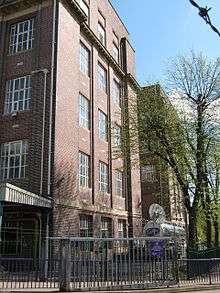
The firm's first major breakthrough occurred in 1866 when Richard and George introduced an improved cocoa into Britain.[10] A new cocoa press developed in the Netherlands removed some of the unpalatable cocoa butter from the cocoa bean.[10] The firm began exporting its products in the 1850s.[10][13] In 1861, the company created Fancy Boxes — a decorated box of chocolates — and in 1868 they were sold in boxes in the shape of a heart for Valentine's Day.[11] Boxes of filled chocolates quickly became associated with the holiday.[11]
Manufacturing their first Easter egg in 1875, Cadbury created the modern chocolate Easter egg after developing a pure cocoa butter that could be moulded into smooth shapes.[14] By 1893, Cadbury had 19 different varieties of chocolate Easter egg on sale.[14]
In 1878, the brothers decided to build new premises in countryside four miles from Birmingham.[9] The move to the countryside was unprecedented in business.[9] Better transport access for milk that was inward shipped by canal, and cocoa that was brought in by rail from London, Southampton and Liverpool docks was taken into consideration. With the development of the Birmingham West Suburban Railway along the path of the Worcester and Birmingham Canal, they acquired the Bournbrook estate, comprising 14.5 acres (5.9 ha) of countryside 5 miles (8.0 km) south of the outskirts of Birmingham. Located next to the Stirchley Street railway station, which itself was opposite the canal, they renamed the estate Bournville and opened the Bournville factory the following year.
In 1893, George Cadbury bought 120 acres (49 ha) of land close to the works and planned, at his own expense, a model village which would 'alleviate the evils of modern more cramped living conditions'. By 1900 the estate included 314 cottages and houses set on 330 acres (130 ha) of land. As the Cadbury family were Quakers there were no pubs in the estate.[9]
In 1897, following the lead of Swiss companies, Cadbury introduced its own line of milk chocolate bars.[15] In 1899 Cadbury became a private limited company.[15]
1900–1969
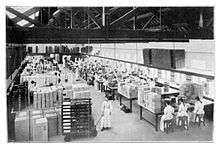
In 1905, Cadbury launched its Dairy Milk bar, a production of exceptional quality with a higher proportion of milk than previous chocolate bars.[10] Developed by George Cadbury Jr, it was the first time a British company had been able to mass-produce milk chocolate.[15] From the beginning, it had the distinctive purple wrapper.[15] It was a great sales success, and became the company's best selling product by 1914.[10] The stronger Bournville Cocoa line was introduced in 1906.[10] Cadbury Dairy Milk and Bournville Cocoa were to provide the basis for the company's rapid pre-war expansion.[10] In 1910, Cadbury sales overtook those of Fry for the first time.[15]
Cadbury's Milk Tray was first produced in 1915 and continued in production throughout the remainder of the First World War. More than 2,000 of Cadbury's male employees joined the British Armed Forces, and to support the British war effort, Cadbury provided chocolate, books and clothing to the troops.[16] George Cadbury handed over two company-owned buildings for use as hospitals – "The Beeches" and "Fircroft", and the management of both hospitals earned the War Office's highest award.[16] Factory girls, dubbed 'The Cadbury Angels', volunteered to do the laundry of injured soldiers recovering in the hospitals.[16] After the war, the Bournville factory was redeveloped and mass production began in earnest. In 1918, Cadbury opened their first overseas factory in Hobart, Tasmania.

In 1919, Cadbury merged with J. S. Fry & Sons, another leading British chocolate manufacturer, resulting in the integration of well-known brands such as Fry's Chocolate Cream and Fry's Turkish Delight.[10] In 1921, the many small Fry's factories around Bristol were closed down, and production was consolidated at a new Somerdale Factory, outside Bristol.[15]
Cadbury expanded its product range with Flake (1920), Creme eggs (1923), Fruit and Nut (1928), and Crunchie (1929, originally under the Fry's label). By 1930, Cadbury was the 24th-largest British manufacturing company as measured by estimated market value of capital.[10] Cadbury took direct control of the under-performing Fry in 1935.[15] Dairy Milk Whole Nut arrived in 1933, and tins of Roses were introduced in 1938.[17] Roses has become a very popular Christmas (and Mother's Day) gift.[18]
Chocolate ceased to be a luxury product and became affordable to the working classes for the first time.[15] By the mid-1930s, Cadbury estimated that 90 percent of the British population could afford to buy chocolate.[19] By 1936, Dairy Milk accounted for 60 percent of the UK milk chocolate market.[15]
During World War II, parts of the Bournville factory were turned over to war work, producing milling machines and seats for fighter aircraft. Workers ploughed football fields to plant crops. As chocolate was regarded as an essential food, it was placed under government supervision for the entire war. The wartime rationing of chocolate ended in 1950, and normal production resumed. Cadbury subsequently invested in new factories and had an increasing demand for their products.[20] In 1952 the Moreton factory was built.[21]
Cadbury has been a holder of a Royal Warrant from Queen Elizabeth II since 1955.[5] In 1967, Cadbury acquired an Australian confectioner, MacRobertson's, beating a rival bid from Mars.[22] As a result of the takeover, Cadbury built a 60 percent market share in the Australian market.[22]
Schweppes merger (1969)
Cadbury merged with drinks company Schweppes to form Cadbury Schweppes in 1969.[23] Head of Schweppes, Lord Watkinson, became chairman, and Adrian Cadbury became deputy chairman and managing director.[23] The benefits of the merger were to prove elusive.[24]
The merger put an end to Cadbury's close links to its Quaker founding family and its perceived social ethos by instilling a capitalist venturer philosophy in management.[25]
In 1978, the company acquired Peter Paul, the third largest chocolate manufacturer in the United States for $58 million, which gave it a 10 percent share of the world's largest confectionery market.[26] The highly successful Wispa chocolate bar was launched in the North East of England in 1981, and nationwide in 1984.[27] In 1982, trading profits were greater outside of Britain than in the UK for the first time.[24]
In 1986, Cadbury Schweppes sold its Beverages and Foods division to a management buyout known as Premier Brands for £97 million.[28] This saw the company divest itself of such brands as Typhoo Tea, Kenco, Smash and Hartley Chivers jam.[28] The deal also saw Premier take the licence for production of Cadbury brand biscuits and drinking chocolate.[28]
Meanwhile, Schweppes switched its alliance in the UK from Pepsi to Coca-Cola, taking a 51 percent stake in the joint venture Coca-Cola Schweppes.[28] The acquisition of Canada Dry doubled its worldwide drinks market share, and it took a 30 percent stake in Dr Pepper.[28] As a result of these acquisitions, Cadbury Schweppes became the third largest soft drinks manufacturer in the world.[28] In August 1988, the company sold its U.S. confectionery operations to Hershey's for $284.5 million cash plus the assumption of $30 million in debt.[29]
In 1999, Cadbury Schweppes sold its worldwide beverage businesses to The Coca-Cola Company except in North America and continental Europe for $700 million.[30]
Snapple, Mistic and Stewart's (formerly Cable Car Beverage) were sold by Triarc to Cadbury Schweppes in 2000 for $1.45 billion.[31] In October of that same year, Cadbury Schweppes purchased Royal Crown from Triarc.[32] In 2003, Cadbury Schweppes acquired Adams, the US chewing gum operations of Pfizer Inc., for $4.2 billion, making Cadbury the world's biggest confectionary company.[33] In 2005, Cadbury Schweppes acquired Green & Black's for £20 million.[34]
Schweppes demerger
In March 2007, it was revealed that Cadbury Schweppes was planning to split its business into two separate entities: one focusing on its main chocolate and confectionery market; the other on its US drinks business.[35] The demerger took effect on 2 May 2008, with the drinks business becoming Dr Pepper Snapple Group and Cadbury Schweppes plc becoming Cadbury plc.[36] In December 2008 it was announced that Cadbury was to sell its Australian beverage unit to Asahi Breweries.[37]
2007–2010
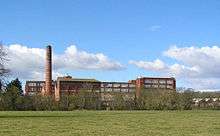
In October 2007, Cadbury announced the closure of the Somerdale Factory, in Keynsham, Somerset, formerly part of Fry's. Between 500 and 700 jobs were affected by this change. Production transferred to other plants in England and Poland.[38]
In 2008, Monkhill Confectionery, the Own Label trading division of Cadbury Trebor Bassett was sold to Tangerine Confectionery for £58 million cash. This sale included factories at Pontefract, Cleckheaton and York and a distribution centre near Chesterfield, and the transfer of around 800 employees.[39]
In mid-2009, Cadbury replaced some of the cocoa butter in their non-UK chocolate products with palm oil. Despite stating this was a response to consumer demand to improve taste and texture, there was no "new improved recipe" claim placed on New Zealand labels. Consumer backlash was significant from environmentalists and chocolate lovers in both Australia and New Zealand, with consumers objecting to both the taste from the cheaper formulation, and the use of palm oil given its role in the destruction of rainforests. By August 2009, the company announced that it was reverting to the use of cocoa butter in New Zealand and Australia, although palm oil is still listed as an ingredient in Cadbury's flavoured sugar syrup based fillings (where it referred to as 'vegetable oil').[40] In addition, Cadbury stated they would source cocoa beans through Fair Trade channels.[41] In January 2010 prospective buyer Kraft pledged to honour Cadbury's commitment.[42]
Acquisition and subsidiary (2009-)
On 7 September 2009, Kraft Foods made a £10.2 billion (US$16.2 billion) indicative takeover bid for Cadbury. The offer was rejected, with Cadbury stating that it undervalued the company.[43] Kraft launched a formal, hostile bid for Cadbury, valuing the firm at £9.8 billion on 9 November 2009.[44] The UK Business Secretary Peter Mandelson warned Kraft not to try to "make a quick buck" from the acquisition of Cadbury.[45]
On 19 January 2010, it was announced that Cadbury and Kraft Foods had reached a deal and that Kraft would purchase Cadbury for £8.40 per share, valuing Cadbury at £11.5bn (US$18.9bn). Kraft, which issued a statement stating that the deal will create a "global confectionery leader", had to borrow £7 billion (US$11.5bn) in order to finance the takeover.[46]
The Hershey Company, based in Pennsylvania, manufactures and distributes Cadbury-branded chocolate (but not its other confectionery) in the United States and has been reported to share Cadbury's "ethos".[47] Hershey had expressed an interest in buying Cadbury because it would broaden its access to faster-growing international markets.[48] But on 22 January 2010, Hershey announced that it would not counter Kraft's final offer.[49][50][51]
The acquisition of Cadbury faced widespread disapproval from the British public, as well as groups and organisations including trade union Unite,[52] who fought against the acquisition of the company which, according to Prime Minister Gordon Brown, was very important to the British economy.[53] Unite estimated that a takeover by Kraft could put 30,000 jobs "at risk",[47][54][55] and UK shareholders protested over the mergers and acquisitions advisory fees charged by banks. Cadbury's M&A advisers were UBS, Goldman Sachs and Morgan Stanley.[56][57][58] Controversially, RBS, a bank 84% owned by the United Kingdom Government, funded the Kraft takeover.[59][60]
.jpg)
On 2 February 2010, Kraft secured over 71% of Cadbury's shares thus finalising the deal.[61] Kraft had needed to reach 75% of the shares in order to be able to delist Cadbury from the stock market and fully integrate it as part of Kraft. This was achieved on 5 February, and the company announced that Cadbury shares would be de-listed on 8 March.[62] On 3 February, the Chairman Roger Carr, chief executive Todd Stitzer and chief financial officer Andrew Bonfield[63] all announced their resignations. Stitzer had worked at the company for 27 years.[64] On 9 February, Kraft announced that they were planning to close the Somerdale Factory, Keynsham, with the loss of 400 jobs.[65] The management explained that existing plans to move production to Poland were too advanced to be realistically reversed, though assurances had been given regarding sustaining the plant. Staff at Keynsham criticised this move, suggesting that they felt betrayed and as if they have been "sacked twice".[66] On 22 April 2010, Phil Rumbol, the man behind the famous Cadbury Gorilla advertisement, announced his plans to leave the Cadbury company in July following Kraft's takeover.[67]
The European Commission decided that Kraft would have to divest Cadbury's confectionery businesses in Poland (Wedel) and Romania (Kandia). In June 2010, the Polish division, Cadbury-Wedel, was sold to Lotte of Korea. As part of the deal Kraft kept the Cadbury, Hall's and other brands along with two plants in Skarbimierz. Lotte took over the plant in Warsaw along with the E Wedel brand.[68] Kandia was sold back to the Meinl family, which had owned the brand from 2003 to 2007.[69]
On 4 August 2011, Kraft Foods announced they would be splitting into two companies beginning on 1 October 2012. The confectionery business of Kraft became Mondelez International, of which Cadbury would become a subsidiary.[70][71]
In response to diminishing margins in early 2014, Mondelez hired Accenture to implement a US$3 billion cost-cutting programme of the company's assets including Cadbury and Oreo. Beginning in 2015, Mondelez began closing Cadbury factories in several developed countries including Ireland, Canada, the United States, and New Zealand and shifting production to "advantaged" country locations like China, India, Brazil, and Mexico. The closure of Cadbury factories in centres such as Dublin, Montreal, Chicago, Philadelphia, and Dunedin in New Zealand generated outcries from the local populations. The plan received approval from several market shareholders including the Australian and New Zealand banks Westpac and ASB Bank.[72][73][74]
In January 2017, Cadbury became the official snack partner of the Premier League, and sponsors the Premier League Golden Boot and Premier League Golden Glove awards.[75]
Operations
Head office
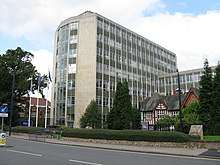
Cadbury has its head office at Cadbury House in the Uxbridge Business Park in Uxbridge, London Borough of Hillingdon, England.[76] The company occupies 84,000 square feet (7,800 m2) of leased space inside Building 3 of the business park,[77] which it shares with Mondelez's UK division.[78] After acquiring Cadbury, Kraft confirmed that the company would remain at Cadbury House.[79]
Cadbury relocated to Uxbridge from its previous head office at 25 Berkeley Square in Mayfair, City of Westminster in 2007 as a cost-saving measure.[80][81] In 1992, the company leased the space for £55 per 1 square foot (0.093 m2);[77] by 2002 this had reached £68.75 per square foot.[80]
Production sites
Bournville
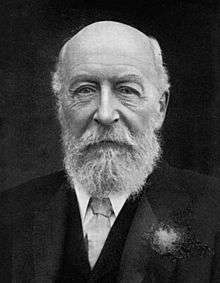
Located four miles south of Birmingham, England, the Cadbury plant in Bournville was opened in 1879 by company founder John Cadbury's son George, whose aim was that one-tenth of the Bournville estate should be "laid out and used as parks, recreation grounds and open space." It subsequently became known as "the factory in a garden".[82] Cadbury's dark chocolate bar, Bournville, is named after the model village, and was first sold in 1908.[83]
Bournville employs almost 1,000 people.[84] In 2014, Mondelez announced a £75 million investment in the site,[84] with Cadbury stating it “reinforces Bournville's position at the heart of the British chocolate industry”.[85]
Bournville is home to Mondelez's Global Centre of Excellence for Chocolate research and development, so every new chocolate product created by Cadbury starts life at the Birmingham plant.[84]
Markets
United Kingdom
 | |
| ISIN | GB00B2PF6M70 |
|---|---|
| Industry | food industry |
| Founded | 1824 |
| Founder | John Cadbury |
| Headquarters | Bournville, Birmingham, England |
Number of employees | 71,657 (2008) |
| Parent | Mondelēz International |
| Website | www |
The confectionery business in the UK is called Cadbury (formerly Cadbury Trebor Bassett) and, as of August 2004, had eight factories and 3,000 staff in the UK. Mondelez also sells biscuits bearing the Cadbury brand, such as Cadbury Fingers. Cadbury also owns Trebor Bassett, Fry's and Maynards.
Ice cream based on Cadbury products, like 99 Flake, is made under licence by Frederick's Dairies. Cadbury cakes and chocolate spread are manufactured under licence by Premier Foods, but the cakes were originally part of Cadbury Foods Ltd with factories at Blackpole in Worcester and Moreton on the Wirral, with distribution depots throughout the UK.
Other Kraft subsidiaries in the UK include Cadbury Two LLP, Cadbury UK Holdings Limited, Cadbury US Holdings Limited, Cadbury Four LLP, Cadbury Holdings Limited, and Cadbury One LLP.
Ireland
-112777_(25448247034).jpg)
Cadbury Ireland Limited is based in Coolock in Dublin, where the headquarters of Cadbury Ireland are located, and Tallaght. The third is in Rathmore, County Kerry. Products made by Cadbury in Ireland include Cadbury Dairy Milk Range, Cadbury Twirl, Cadbury Cadbury Snacks Range Flake and Boost (formerly Moro). Cadbury used to produce the Time Out bar in Ireland for the European market however this production was moved to Poland.[86]
United States
 | |
| ISIN | GB00B2PF6M70 |
|---|---|
| Industry | food industry |
| Founded | December 2002 |
| Founder | John Cadbury |
| Headquarters | Parsippany-Troy Hills, New Jersey, United States |
| Products | Trident, Certs, Chiclets, Halls (cough drop) |
| Owners | Mondelez International |
Number of employees | 71,657 (2008) |
| Website | us |
| Footnotes / references | |
| Cadbury USA (chocolate) | |
| Manufacturer | Hershey (licensee) |
| Products | Cadbury Creme Egg, Cadbury Dairy Milk, Mini Eggs |
| Website | cadburyusa |
Cadbury Adams produces candy, gum, breath mints and cough drops. It is headquartered in Parsippany, New Jersey. The company was formed after the then Cadbury Schweppes purchased the Adams brand from Pfizer in December 2002 for US$4.2 billion.
American Chicle was purchased by Warner-Lambert in 1962; Warner-Lambert renamed the unit Adams in 1997 and merged with Pfizer in 2000.
In 1978, Cadbury merged with Peter Paul, makers of Mounds and Almond Joy.[87] In 1988, The Hershey Company acquired the U.S. rights to their chocolate business. Accordingly, although the Cadbury group's chocolate products have been sold in the U.S. since 1988, the products are manufactured by Hershey, causing complaints by consumers, who claim they are inferior to the originals.[88] Before the May 2008 demerger, the North American business also contained beverage unit Cadbury Schweppes Americas Beverages. In 1982, Cadbury Schweppes purchased the Duffy-Mott Company.[89]
Cadbury Adams' products include:
- Maynards
- Wine Gums (original and Sour)
- Swedish Fish
- Swedish Berries
- Juicy Squirts (Sours, Citrus, and Berry)
- Original Gummies
- Fuzzy Peach
- Sour Chillers
- Sour Patch Kids
- Mini Fruit Gums
- Sour Cherry Blasters
- Fruit Mania
- Bassett's Liquorice Allsorts
- Gum
- Black Jack chewing gum
- Bubbaloo bubble gum
- Bubblicious bubble gum
- Chiclets
- Clorets
- Dentyne
- Freshen Up Gum
- Sour Cherry Gum (Limited)
- Sour Apple Gum (Limited)
- Stride
- Trident
- Other
- Certs breath mints
- Halls (cough drop)
- Discontinued products
- Beemans chewing gum
- Cinn*a*Burst gum
- Clove gum
- Fruit*a*Burst gum
- Mint*a*Burst gum
- Sparkies
Australia
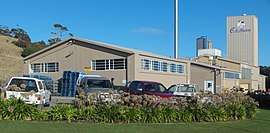
Cadbury's products were first imported into Australia as early as 1853 when 3 cases of Cadbury's cocoa and chocolate were advertised for sale in Adelaide.[90] Cadbury's first overseas order in 1881 was made for the Australian market. In 1919, as part of its plans to expand internationally, the company decided to build a factory in Australia. In 1920 Claremont, Tasmania was chosen for the location because of its close proximity to the city of Hobart, good source of inexpensive hydro-electricity and plentiful supply of high-quality fresh milk. The first products from the factory were sold in 1922.[91] The Claremont factory was modelled on Bournville, with its own village and sporting facilities.[92][93] Cadbury operates three Australian factories; two in Melbourne, Victoria (Ringwood and Scoresby), and one in Hobart, Tasmania (Claremont). Cadbury also operates a milk-processing plant in Cooee, Tasmania. Claremont factory was once a popular tourist attraction and operated daily tours; however, the factory ceased running full tours mid-2008, citing health and safety reasons.[94] Cadbury has been upgrading its manufacturing facility at Claremont, Tasmania, Australia, since 2001.[95]
On 27 February 2009, the confectionery and beverages businesses of Cadbury Schweppes in Australia were formally separated and the beverages business began operating as Schweppes Australia Pty Ltd. In April 2009, Schweppes Australia was acquired by Asahi Breweries.[96] In late June 2012, Cadbury introduced Marvellous Creations a new chocolate range with three flavours – Peanut Toffee Cookie, Jelly Crunchie Bits or Jelly Popping Candy Beanies covered in Dairy Milk Chocolate.[97]
In 2015 the Australian Cadbury factory, located in Hobart, reduced its work force by 80[98] and in 2017 closed its visitor's centre.[99] In August 2017 Cadbury announced that 50 workers will be shed from its Hobart factory.[100] Within Australia there is debate regarding halal certification. Many of Cadbury's products are halal certified.[101] This certification has generated controversy, especially from One Nation politician Pauline Hanson.[102][103]
New Zealand
Cadbury had also operated a factory in Dunedin in New Zealand's South Island until its closure in March 2018. In 1930, Cadbury partnered with local confectionery businessman Richard Hudson, who owned a chocolate, confectionery, biscuit factory on Castle Street. Hudson's factory was rebranded as Cadbury Hudson and later became known as the Cadbury Confectionery.[104][105][106] Cadbury later established a second factory in Auckland in the North Island. In 2003, Cadbury established a tourist attraction on the premises of the Dunedin factory known as Cadbury World, which featured a large chocolate waterfall. In 2007, Cadbury closed down its Auckland factory, leading to the loss of 200 jobs. In 2009, the Cadbury Dunedin factory attracted criticism from consumers and local environmentalists when it replaced cocoa butter with palm oil. In response, the company backtracked but still retained palm oil as a filling in some ingredients. Over the next several years, Cadbury began downsizing its products, including trimming chocolate blocks in 2015.[107]
On 16 February 2017, it was reported that Cadbury would be closing its factory in Dunedin, New Zealand by March 2018. This is estimated to lead to the loss of 350 jobs. Amanda Banfield, Mondelez's vice-president for Australia, New Zealand, and Japan, clarified that the closure was done due to Mondelez's decision to shift chocolate manufacturing to Cadbury's Australian factories.[105][108][109] However, Mondelez has also confirmed that Dunedin's Cadbury World tourist attraction would remain open due to its popularity with tourists.[110]
Following four weeks of consultations with local Cadbury employees, the Mayor of Dunedin Dave Cull, and local trade union representatives, Banfield confirmed that the closure would go ahead the following year due to the lack of viable options to continue production in New Zealand. She also confirmed that Cadbury would offer a redundancy support package to staff and would also sponsor staff willing to move to Australia to work. Mondelez also confirmed that it was looking for a third-party manufacturer to continue making Cadbury's New Zealand brands Pineapple Lumps, Jaffas, Chocolate Fish and Buzz Bar.[111] In early June 2017, local city councillor Jim O'Malley and a group of volunteers launched a crowdfunding campaign to keep the Dunedin factory running on a portion of the site.[112] They formed a group called Dunedin Manufacturing Holdings (DMH). Despite generating NZ$6 million in funds, DMH abandoned its bid on 22 June due to Mondelez's stringent production and supply requirements and difficulties in acquiring manpower and machinery. Mondelez has also indicated that it is negotiating with two local chocolate companies to ensure the production of iconic local brands such as Pineapple Lumps, Jaffas, Chocolate Fish, Buzz Bars, and Pinky Bars in New Zealand.[113] Following the failure of DMH's bid, spokesperson O'Malley announced on 12 September that his group would launch a new crowdfunding campaign to buy and expand local craft chocolate manufacturer OCHO (the Otago Chocolate Company).[114]
On 17 October 2017, Cadbury announced that it would be shifting all production of its New Zealand brands to Australia after failing to find a local supplier. The termination of New Zealand production will take effect in March 2018. Mondelez's New Zealand country head James Kane confirmed the shift on the grounds that the production of Cadbury products would require certain technologies, production processes and skills that local New Zealand manufacturers lacked.[115][116]
On 4 May, it was reported that the Dunedin Cadbury World would be closing down after the Ministry of Health purchased the entire former Cadbury factory site to make way for a new public hospital. Mondelez area vice-president Banfield confirmed that Cadbury had sold the former factory site to the Ministry of Health for an undisclosed amount.[117][118][119]
Canada
Cadbury's Canadian head office is located in Toronto. Cadbury Canada produce and import several products that are sold under the Cadbury and Maynards labels, including the following:
|
|
Cadbury Canada is now part of Mondelez Canada and products are featured on the Snackworks website.
India
 | |
| ISIN | GB00B2PF6M70 |
|---|---|
| Industry | food industry |
| Founded | 19 July 1948 |
| Founder | John Cadbury |
| Headquarters | Mumbai, India |
Key people | Anand Kripalu, Managing Director[120] |
| Products | Cadbury Dairy Milk, 5-star, Perk, Gems, Eclairs, Oreo and Bournvita |
Number of employees | 2000 |
| Parent | Mondelēz International |
| Website | cadburygifting |
In 1948, Cadbury India began its operations in India by importing chocolates. On 19 July 1948, Cadbury was incorporated in India. It now has manufacturing facilities in Thane, Induri (Pune) and Malanpur (Gwalior), Hyderabad, Bangalore and Baddi (Himachal Pradesh) and sales offices in New Delhi, Mumbai, Kolkata and Chennai. The corporate head office is in Mumbai. The head office is presently situated at Pedder Road, Mumbai, under the name of "Cadbury House". This monumental structure at Pedder Road has been a landmark for the citizens of Mumbai since its creation. Since 1965 Cadbury has also pioneered the development of cocoa cultivation in India. For over two decades, Cadbury has worked with the Kerala Agricultural University to undertake cocoa research.[121][122]
Currently, Cadbury India operates in five categories – Chocolate confectionery, Beverages, Biscuits, Gum and Candy. Its products include Cadbury Dairy Milk, Dairy Milk Silk, Bournville, 5-Star, Temptations, Perk, Eclairs, Bournvita, Celebrations, Gems, Bubbaloo, Cadbury Dairy Milk Shots, Toblerone, Halls, Bilkul, Tang, and Oreo.[123][124]
It is the market leader in the chocolate confectionery business with a market share of over 70%.[125] On 21 April 2014, Cadbury India changed its name to Mondelez India Foods Limited.[126] In 2017, Cadbury/Mondelez agreed to pay a $13 million FCPA penalty for making illicit payments to government officials to obtain licences and approvals to build a factory in Baddi.[127][128]
Malta
In 2012, Alf Mizzi & Sons Marketing (Ltd) took over the importation and distribution of Cadbury, as well as several other Mondelez brands. Most of the Cadbury products are imported directly from the UK. The advertising of the brand was taken over by Sloane Ltd., which proved to be highly successful in creating market specific commercials, reaching more of the Maltese population than ever through digital advertising.
Advertising
The Cadbury signature logo is derived from the signature of William Cadbury.[130] It was adopted as the worldwide logo in the 1970s.[130]
Cadbury famously trademarked the colour purple for chocolates with registrations in 1995[131] and 2004.[132] However, the validity of these trademarks is the matter of an ongoing legal dispute following objections by Nestlé.[133][134]
The 2007 Gorilla advertisement promoting Cadbury Dairy Milk – featuring Phil Collins "In the Air Tonight", won numerous awards, including Gold at the British Television Advertising Awards in 2008.[135] Four commercials for Cadbury products featured in the top 50 of Channel 4’s 2000 UK poll of the "100 Greatest Adverts". Cadbury Flake, featuring Flake Girl, was ranked 26th, Cadbury Dairy Milk Fruit & Nut, featuring the slogan 'Everyone's a fruit and nutcase' sung by comedian Frank Muir, ranked 36th, Fry's Turkish Delight, with the slogan 'Full of Eastern Promise' accompanied with model Jane Lumb, ranked 37th, and Cadbury Milk Tray (which since 1968 has been advertised by the 'Milk Tray Man', a tough James Bond–style figure who undertakes daunting 'raids' to surreptitiously deliver a box of Milk Tray chocolates to a lady),[136] the "Avalanche" advert where he races ahead of it to deliver the chocolates, ranked 48th.[137] Cadbury has also been promoted by celebrities, including the pop group the Spice Girls who had their own Cadbury brand of chocolate bar and chocolates.[138]
Executive pay
In 2008, Todd Stitzer, Cadbury's CEO, was paid a £2,665,000 bonus. Combined with his annual salary of £985,000 and other payments of £448,000 this gives a total remuneration of over £4 million.[139]
Accounting
In July 2007, Cadbury Schweppes announced that it would be outsourcing its transactional accounting and order capture functions to Shared Business Services (SBS) centres run by a company called Genpact (a businesses services provider) in India, China, and Romania. This was to affect all business units and be associated with US and UK functions being transferred to India by the end of 2007, with all units transferred by mid-2009. Depending on the success of this move, other accounting Human Resources functions may follow. This development is likely to lead to the loss of several hundred jobs worldwide, but also to several hundred jobs being created, at lower salaries commensurate with wages paid in developing countries.[140]
Products
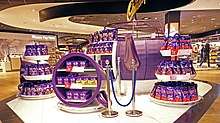

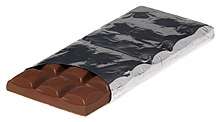
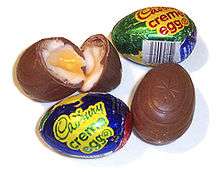
Major chocolate brands produced by Cadbury include the bars Dairy Milk, Crunchie, Caramel, Wispa, Boost, Picnic, Flake, Curly Wurly, Chomp, and Fudge; chocolate Buttons; the boxed chocolate brand Milk Tray; and the twist-wrapped chocolates Heroes which are most popular around holidays, such as Christmas and Halloween.
Creme Eggs are only sold between New Year's Day and Easter. Tony Bilborough from Cadbury told BBC Radio 5 Live: "There's something special about Creme Egg season. We long for it in those long, eggless days of summer and autumn."[141]
As well as Cadbury's chocolate, the company also owns Maynards and Halls, and is associated with several types of confectionery including former Trebor and Bassett's brands or products such as Liquorice Allsorts, Jelly Babies, Flumps, Mints, Black Jack chews, Trident gum, and Softmints. Global sales of Cadbury products amounted to £491M in the 52 weeks to 16 August 2014.[142]
Notable product introductions include:
- 1866: Cocoa Essence
- 1875: Easter Eggs
- 1897: Milk Chocolate and Fingers
- 1905: Dairy Milk
- 1908: Bournville
- 1914: Fry's Turkish Delight
- 1915: Milk Tray
- 1920: Flake
- 1923: Creme Egg (launched as Fry's)
- 1926: Cadbury Dairy Milk Fruit & Nut
- 1929: Crunchie (launched as Fry's)
- 1938: Roses
- 1948: Fudge
- 1958: Picnic
- 1960: Dairy Milk Buttons
- 1965: Cadbury Eclairs
- 1968: Aztec
- 1970: Curly Wurly
- 1974: Snack
- 1976: Double Decker
- 1976: Starbar
- 1981: Wispa (relaunched 2007)
- 1985: Boost
- 1987: Twirl
- 1992: Time Out
- 1995: Wispa Gold (relaunched 2009 and 2011)
- 1996: Fuse (promotional relaunched 2015)
- 1999: Heroes
- 2001: Brunch Bar, Dream and Flake
- 2009: Dairy Milk Silk[143]
- 2010: Dairy Milk Bliss
- 2011: Big Race oreo
- 2012: Marvellous Creations and Crispello
- 2014: Pebbles
- 2014: Bubbly
- 2016: Cadbury Silk Oreo
Incidents
2006 salmonella scare
On 20 January 2006, Cadbury Schweppes detected a strain of the Salmonella Montevideo (SmvdX07) bacteria, affecting seven of its products.[144][145] The contamination was caused by a leaking pipe, from which waste water dripped onto a chocolate crumb production line at the company's plant in Marlbrook, Herefordshire.[146][147] It was not until around six months after the leak was detected that Cadbury Schweppes notified the Food Standards Agency, a delay which Cadbury Schweppes was unable to explain satisfactorily, and for which it was criticised.[144][148] The Food Standards Agency ordered the company to recall more than a million chocolate bars.[149] In December 2006, the company announced that the cost of dealing with the incident reached £30 million.[150]
In April 2007, Birmingham City Council announced that it would be prosecuting Cadbury Schweppes in relation to three alleged offences of breaching food safety legislation. At that time, the Health Protection Agency identified 37 people who had been infected with Salmonella Montevideo.[151][146] One of the alleged victims had to be kept on a hospital isolation ward for five days after eating a Cadbury's caramel bar.[152] An investigation that was carried by Herefordshire Council led to a further six charges being brought.[150] The company pleaded guilty to all nine charges,[153][154] and was fined one million pounds at Birmingham Crown Court—the sentencing of both cases was brought together.[155] Analysts have said the fine is not material to the group, with mitigating factors limiting the fine being that the company quickly admitted its guilt and said it had been mistaken that the infection did not pose a threat to health.[155]
2007 recalls
On 10 February 2007, Cadbury recalled some of its Easter eggs due to a labelling error. The products were produced in a factory handling nuts, potential allergens, but this was not made clear on the packaging. Cadbury said the products were "perfectly safe" for people without nut allergies to eat.[156]
On 14 September 2007, Cadbury Schweppes investigated a manufacturing error over allergy warning, recalling for the second time in two years thousands of chocolate bars. A printing mistake at Somerdale Factory resulted in the omission of tree nut allergy labels from 250g Dairy Milk Double Chocolate bars.[157]
2008 melamine contamination in China
On 29 September 2008, Cadbury withdrew all of its 11 chocolate products made in its three Beijing factories, on suspicion of contamination with melamine. The recall affected the mainland China markets, Taiwan, Hong Kong and Australia.[158] Products recalled included Dark Chocolate, a number of products in the 'Dairy Milk' range and Chocolate Éclairs.[159]
2014 pork traces in Malaysia
Cadbury recalled two chocolate products after it was tested positive for traces of pork DNA, namely Cadbury Dairy Milk Hazelnut and Cadbury Dairy Milk Roast Almond.[160] The traces were found during a periodic check for non-halal ingredients in food products by the Ministry of Health in Malaysia which on 24 May 2014 said two of three samples of the company's products may contain pork traces.[161]
On 2 June 2014, Malaysia's Department of Islamic Development (JAKIM) declared that the sample did not contain pig DNA, as claimed in earlier reports. This statement was made after new tests were conducted.
JAKIM reportedly said in a statement that they tested 11 samples of Cadbury Dairy Milk Hazelnut, Cadbury Dairy Milk Roast Almond and other products from the company's factory but none of them tested positive for pork. The investigation followed reports that unscheduled checks had shown that two chocolates produced by Mondelez International Inc., the parent company of Cadbury, violated Islamic law and led to a boycott of all its products in the country.[162]
2017 "Easter" controversy
-112774_(26027101296).jpg)
In 2017, the Church of England condemned the company and the National Trust for rebranding their annual "Easter Egg Trails" as "Cadbury Egg Hunts".[163] Prime Minister Theresa May called the rebranding "absolutely ridiculous"; however, Cadbury dismissed the criticism, with a spokesperson saying, "it is clear to see that within our communications we visibly state the word Easter. It is included a number of times across promotional materials."[164] An ensuing controversy followed in Australia, where Cadbury was accused of removing the word 'Easter' from the packaging of its Easter eggs. Cadbury Australia rebutted that Easter was mentioned on "the back of pack", and that its eggs were obviously Easter eggs.[165]
2019 "Cadbury Treasures" campaign
In the run-up to Easter 2019, Cadbury launched a "Treasures" promotion in the UK and Ireland that, as well as listing treasure exhibits in various museums, encouraged people to engage in illegal metal-detecting and digging at protected archaeological sites around the British Isles in search of further treasure. This prompted a highly critical reaction from archaeologists.[166]
References
- "Company Profile for Cadbury PLC (CBY)". Archived from the original on 6 October 2008. Retrieved 1 October 2008.
- "Top 10 confectionery brands globally". Confectionery News
- "GTA 5: a Great British export". The Telegraph. 26 November 2015.
- Richardson, Tim (2002). "Sweets: A History of Temptation". p. 255. Bantam Press
- "Royal Warrant Holders: Cadbury". Royalwarrant.org.
- Paton, Maynard (2 January 2004). "Twenty Years Of The FTSE 100". The Motley Fool. Archived from the original on 10 January 2010. Retrieved 10 February 2010.
- "Cadbury PLC (UK): Offer by Kraft Foods Inc. (USA) declared Wholly Unconditional – Changes In FTSE Indices". FTSE Group. 2 February 2010. Archived from the original on 9 February 2010. Retrieved 10 February 2010.
- Jackson, Peter (20 January 2010). "How did Quakers conquer the British sweet shop?". BBC News. Retrieved 15 July 2019.
- Dellheim, Charles (February 1987). "The Creation of a Company Culture: Cadburys, 1861–1931". The American Historical Review. Oxford University Press on behalf of the American Historical Association. 92 (1): 13–44. doi:10.2307/1862781. JSTOR 1862781. PMID 11612055.
- Jones, Geoffrey (1984). "Multinational Chocolate: Cadbury Overseas, 1918–39". Business History. 26 (1): 59–76. doi:10.1080/00076798400000004.
- Mintz, Sidney (2015). The Oxford Companion to Sugar and Sweets. Oxford University Press. p. 157.
- "Chocolate principles to live by". p. 159. MJF Books/Fine Communications, 2005
- "Sales by Public Auction". Supplement to The South Australian Register. Adelaide, Australia. 8 February 1853.
3 cases Cadbury 's Cocoa and Chocolate
- "Amazing archive images show how Cadbury cracked Easter egg market". Birmingham Mail. Retrieved 21 May 2019.
- Fitzgerald, Robert (2005). "Products, Firms and Consumption: Cadbury and the Development of Marketing, 1900–1939". Business History. 47 (4): 511–531. doi:10.1080/00076790500132977.
- "New Cadbury World Display Highlights Bournville Workers' Courage During WW1". Edge Magazine. 15 December 2015. Archived from the original on 22 December 2015. Retrieved 16 December 2015.
- Ascribed to Cadbury plc. (19 January 2010). "A history of Cadbury's sweet success". Times Online. London. Retrieved 30 May 2010.
- "Cadbury Roses fans get in a Christmas twist over wrapper changes". The Guardian. Retrieved 21 May 2019.
- Fitzgerald, Robert (2007). Rowntree and the Marketing Revolution, 1862–1969. Cambridge University Press. p. 23. ISBN 978-0-521-02378-8.
- "The history of Cadbury Schweppes". Birminghamuk.com. Retrieved 26 April 2013.
- Chris Smith; Michael Rowlinson (1990). Reshaping Work: The Cadbury Experience. Cambridge University Press. pp. 78–82. ISBN 978-0-521-32304-8.
- Cadbury, Deborah (2010). Chocolate Wars: The 150-Year Rivalry Between the World's Greatest Chocolate Makers. PublicAffairs. pp. 267–8. ISBN 978-1-58648-925-0.
- Smith, Chris; Rowlinson, Michael (1990). Reshaping Work: The Cadbury Experience. Cambridge University Press. pp. 78–80. ISBN 978-0-521-32304-8.
- Hendry, John (1999). European Cases in Strategic Management. Cengage Learning. p. 83. ISBN 1-86152-577-X.
- Chris Smith; Michael Rowlinson (1990). Reshaping Work: The Cadbury Experience. Cambridge University Press. pp. 78–95. ISBN 978-0-521-32304-8.
- Chris Smith; Michael Rowlinson (1990). Reshaping Work: The Cadbury Experience. Cambridge University Press. p. 88. ISBN 978-0-521-32304-8.
- Chris Smith; Michael Rowlinson (1990). Reshaping Work: The Cadbury Experience. Cambridge University Press. p. 93. ISBN 978-0-521-32304-8.
- Hendry, John (1999). European Cases in Strategic Management. Cengage Learning. pp. 81–82. ISBN 1-86152-577-X.
- The Hershey Company Fact Book 2016. The Hershey Company. p. 11.
- "Coca-Cola completes purchase of Cadbury unit". The New York Times. Bloomberg. 31 July 1999. Retrieved 29 October 2019.
- Holson, Laura M. (18 September 2000). "Cadbury to Pay $1.45 Billion For Snapple". The New York Times. Retrieved 18 June 2008.
- "Royal Crown Cola Company". New Georgia Encyclopedia. 15 September 2006. Retrieved 18 June 2008.
- "The inside story of the Cadbury takeover". Financial Times. Retrieved 17 May 2019.
- "Cadbury gobbles up organic rival". BBC News. 13 May 2005. Retrieved 15 August 2019.
- "Cadbury plans to split business" – BBC News, 14 March 2007.
- "Cadbury plc Demerger" (Press release). Cadbury plc. 7 May 2008. Archived from the original on 13 December 2009. Retrieved 29 December 2009.
- "Cadbury to sell Australian drinks arm". Financial Times. 24 December 2008. Retrieved 17 March 2009.
- "Cadbury factories shed 700 jobs". BBC News. 3 October 2007. Retrieved 5 January 2010.
- Sweet deal as Tangerine buys Monkhill, Yorkshire Post, 18 January 2008
- "About Cadbury". Archived from the original on 13 March 2012. Retrieved 6 February 2016. Cadbury Dairy Milk returns to Cocoa Butter only recipe—Official Press Release, August 2009
- Archived 14 August 2009 at the Wayback Machine Cadbury Dairy Milk to go Fairtrade in 2010 – Choclovers.com, August 2009
- Severin Carrell, Scotland correspondent (23 January 2010). "Kraft pledges to honour Cadbury's Fairtrade sourcing commitments at Guardian.co.uk". The Guardian. London. Retrieved 21 December 2010.
- "Cadbury snubs £10.2bn Kraft move". BBC News. 7 September 2009. Retrieved 7 September 2009.
- "Cadbury rejects hostile Kraft bid". BBC News. 9 November 2009. Retrieved 9 November 2009.
- MacAlister, Terry (4 December 2009). "Don't try to make a quick buck from Cadbury, Mandelson tells Kraft". The Guardian. London. Retrieved 10 January 2010.
- "Cadbury agrees Kraft takeover bid". BBC News. London: BBC. 19 January 2010. Retrieved 19 January 2010.
- Richardson, Tim (16 January 2010). "Get your hands off our sweets!". The Guardian. London. Retrieved 28 April 2010.
- "JP Morgan, BofA gear up to fund Hershey's Cadbury bid". The Business Standard.
- Andrejczak, Matt (22 January 2010). "Hershey: No plans for Cadbury bid". MarketWatch. Retrieved 21 December 2010.
- de la Merced, Michael J. & Nicholson, Chris V. (19 January 2010). "Kraft to Acquire Cadbury in Deal Worth $19 Billion". The New York Times.
- Jannarone, John; Curtin, Matthew (16 January 2010). "Hershey's Chocolate Dreams". The Wall Street Journal.
- "Keep Cadbury Independent – UK and Irish workers unite to stop Kraft swallowing Cadbury". UniteTheUnion.com. Archived from the original on 19 December 2009.
- "Clegg attacks Brown over RBS funding for Cadbury bid". BBC News. 20 January 2010.
- "Debt-heavy Kraft could put 30,000 Cadbury jobs at risk, warns Unite". Unitetheunion.com. Archived from the original on 15 January 2010. Retrieved 21 December 2010.
- Wood, Zoe & Treanor, Jill (19 January 2010). "£2m a day cost of Cadbury deal – plus £12m for the boss". The Guardian. London.
- Costello, Miles (18 December 2009). "Big investors call for inquiry into banks' fees for M&A work". The Times. London.
- Weisenthal, Joe (8 September 2009). "Goldman Sachs, Morgan Stanley Win Big In Kraft-Cadbury's". The Business Insider.
- Taylor, Peter (8 September 2009). "Bankers the big winners in Kraft's tilt for Cadbury". The Daily Telegraph. London. Retrieved 28 April 2010.
- Sunderland, Ruth (22 November 2009). "RBS kept client Cadbury in the dark as it prepared to back Kraft's hostile bid". The Guardian. London. Retrieved 28 April 2010.
- "Clegg attacks Brown over RBS funding for Cadbury bid". BBC News. 20 January 2010.
- "Cadbury deal near end, Kraft CEO sees sleep". Reuters. 2 February 2010.
- Cadbury shares to be de-listed BBC News. 5 February 2010
- "Andrew Bonfield was appointed a non-executive director of Kingfisher plc in February 2010". Archived from the original on 7 October 2011. Retrieved 31 December 2010.
- Cadbury top bosses to step down BBC News. 3 February 2010
- "Cadbury's Bristol plant to close by 2011". BBC News. 9 February 2010. Retrieved 21 December 2010.
- Warde, Miles (16 March 2010). "Cadbury Keynsham workers 'sacked twice'". BBC News. Retrieved 21 December 2010.
- "Cadbury's marketing director to quit". Newstatesman.com. 22 April 2010. Retrieved 21 December 2010.
- Lotte group set to acquire Wedel in Poland from Kraft Confectionery News 28 June 2010.
- "Familia Meinl revine la brandul Kandia". Ziarul Financiar.
- "Factbox – Kraft to split into two companies". Reuters. 5 August 2011. Retrieved 9 October 2017.
- Smith, Aaron (4 August 2017). "Kraft to split into two companies". CNN Money. Retrieved 9 October 2017.
- "Mondelez International Details Cost-Reduction Progress and Strategies to Accelerate Growth; Reaffirms 2015 Outlook and 2016 Margin Target". Mondelez International. Archived from the original on 9 October 2017. Retrieved 9 October 2017.
- Stock, Rob (19 February 2017). "Mondelez's global $4 billion cost-cutting drive behind Dunedin Cadbury factory closure". Stuff.co.nz. Retrieved 9 October 2017.
- "Mondelez's results beat on better pricing, cost cuts". Reuters. 3 May 2017. Retrieved 9 October 2017.
- "Cadbury and Premier League enter partnership". PremierLeague.com. 24 January 2017. Retrieved 5 June 2019.
- "Terms of Use". Cadbury. Retrieved 15 March 2016.
- Heap, Richard. Cadbury's schlep. Property Week. 6 July 2007. Retrieved on 27 April 2010.
- "Mondelez UK Limited". Companies House. Retrieved 3 May 2017.
- Update on progress made since Kraft Foods acquired Cadbury Archived 4 March 2011 at the Wayback Machine." Kraft Foods. 31 January 2011. Retrieved on 6 February 2011.
- Muspratt, Caroline (1 June 2007). "Cadbury swaps Mayfair for Uxbridge". The Telegraph. Retrieved 15 March 2016.
- Savills pre-lets new HQ building at record rent for prestigious business park Archived 26 April 2012 at the Wayback Machine. Reports and Accounts 2007. Savills plc. Retrieved on 27 April 2010.
- "Cadbury: The legacy in Birmingham". BBC. Retrieved 7 August 2019.
- "The History of Chocolate". Cadbury. Retrieved 7 August 2019.
- Griffin, Jon. "Cadbury owner Mondelez announces £75m upgrade of Bournville factory". Birmingham Post.
- "Investment in the Bournville factory". Cadbury.co.uk. Retrieved 7 August 2019.
- "160 jobs lost as Cadbury scraps the Pink Snack bar". thejournal.ie. 26 February 2015. Retrieved 26 February 2015.
- "Hersheys History". Hersheys.com. Archived from the original on 26 January 2010. Retrieved 5 January 2010.
- Narula, Svati Kirsten. "How Cadbury lost the right to sell its own chocolate in the US". Retrieved 14 April 2017.
- "Motts Company History". Motts.com. Retrieved 5 January 2010.
- "Advertising - South Australian Register (Adelaide, SA : 1839 - 1900) - 8 Feb 1853". Retrieved 14 April 2017.
- "CADBURY-FRY-PASCALL LIMITED. CLAREMONT". The Examiner. Launceston, Tasmania. 5 June 1922. Retrieved 14 April 2017.
- www.iconinc.com.au, Icon.Inc -. "Cadbury in Australia". Retrieved 14 April 2017.
- "NEW INDUSTRY FOR TASMANIA CHOCOLATE AND COCOA FACTORY. - CLAREMONT SITE CHOSEN. A BIG SCHEME OUTLINED". The Mercury. Hobart, Tasmania. 26 May 1920. Retrieved 14 April 2017.
- "Cadbury Chocolate Factory Hobart". Retrieved 2 September 2009.
- "Cadbury Schweppes Confectionery Plant". Packaging Gateway. Archived from the original on 22 November 2008. Retrieved 5 January 2010.
- "Cadbury in Australia". Cadbury.com.au. Retrieved 21 December 2010.
- "Cadburys launches new chocolate range".
- "Cadbury to shed 80 jobs in Hobart". SBS. 2 May 2015. Retrieved 1 August 2017.
- Shine, Rhiannon (12 April 2017). "Pauline Hanson's call for boycott of halal-certified Easter eggs could cost jobs, union warns". ABC News. Retrieved 1 August 2017.
- "Cadbury to slash jobs in Hobart". Sky News Australia. 15 August 2017. Retrieved 16 August 2017.
- "Halal Products". Mondelez Australia Pty Ltd. 2017. Retrieved 1 August 2017.
- "Pauline Hanson says 'boycott Cadbury' urging supporters to buy 'non-halal' Easter eggs". Yahoo7 News. 11 April 2017. Retrieved 1 August 2017.
- Windsor, Ben (11 April 2017). "Pauline Hanson: 'Go and buy some non-halal Easter eggs'". SBS. Retrieved 1 August 2017.
- "Our History". Cadbury New Zealand. Retrieved 9 October 2017.
- Editorial (17 February 2017). "The last blow to Cadbury". Otago Daily Times. Retrieved 9 October 2017.
- "Hudson, Richard". New Zealand Business Hall of Fame. Retrieved 9 October 2017.
- "The bitter aftertaste to Cadbury's closing". Otago Daily Times. New Zealand Media and Entertainment. 23 February 2017. Retrieved 9 October 2017.
- Mackenzie, Dene (16 February 2017). "350 jobs to go as Cadbury closes". Otago Daily Times. Retrieved 16 February 2017.
- Rotherham, Fiona; Underhill, Jonathan (16 February 2017). "Cadbury workers had no fore-warning Dunedin factory to close". National Business Review. Retrieved 16 February 2017.
- "Cadbury World to remain open in Dunedin". Otago Daily Times. 16 February 2017. Retrieved 16 February 2017.
- "Cadbury factory closure confirmed". The New Zealand Herald. 17 March 2017. Retrieved 24 March 2017.
- "$3m pledged to save Dunedin Cadbury factory". The New Zealand Herald. 9 June 2017. Retrieved 9 October 2017.
- McNeilly, Hamish (22 June 2017). "Choc shock as Dunedin fundraising campaign drops Cadbury bid". Stuff.co.nz. Retrieved 9 October 2017.
- McNeilly, Hamish (12 September 2017). "Dunedin push to become premium chocolate maker". Stuff.co.nz. Retrieved 9 October 2017.
- "Cadbury production moving to Australia". Otago Daily Times. 17 October 2017. Retrieved 17 October 2017.
- "Cadbury production moving to Australia". The New Zealand Herald. 17 October 2017. Retrieved 17 October 2017.
- McNeilly, Hamish (4 May 2018). "Popular tourist attraction Cadbury World closing to make way for $1.4 billion Dunedin Hospital". Stuff.co.nz. Retrieved 4 May 2018.
- "Cadbury World to close". Otago Daily Times. 4 May 2018. Retrieved 4 May 2018.
- "Dunedin Hospital announcement: What you need to know". Otago Daily Times. 4 May 2018. Retrieved 4 May 2018.
- "Cadbury Krafts Tang India plan". The Hindu Business Line. 19 November 2010. Archived from the original on 22 November 2010. Retrieved 21 December 2010.
- "Cadbury India Ltd. – Company Overview". Cadbury India. Archived from the original on 2 February 2007. Retrieved 29 August 2010.
- "Cadbury India Ltd. – Company Overview". Cadburyindia.com. Archived from the original on 2 February 2007. Retrieved 21 December 2010.
- Singh, Namrata (19 June 2010). "Cadbury India puts in place new top brass". The Times of India. Retrieved 21 December 2010.
- "Businessworld – NO. 22 : CADBURY INDIA". Businessworld.in. 24 April 2007. Archived from the original on 17 December 2011. Retrieved 21 December 2010.
- "Cadbury India – Cadbury Schweppes Profile – History of Cadbury India". Iloveindia.com. 21 July 2007. Retrieved 21 December 2010.
- "Cadbury India – Change of name". Press Trust of India. 21 April 2014.
- "SEC.gov | Spotlight on Foreign Corrupt Practices Act". www.sec.gov. Retrieved 5 July 2017.
- "Mondelez in $13 million SEC settlement tied to India payments". Reuters. 9 January 2017. Retrieved 5 July 2017.
- "Chocolate wars break out over the colour purple". The Telegraph. Retrieved 5 August 2019.
- Cadbury, Deborah (2010). Chocolate Wars: The 150-Year Rivalry Between the World's Greatest Chocolate Makers. PublicAffairs. pp. 269–70. ISBN 978-1-58648-925-0.
- "Trade mark number UK0002020876A". Intellectual Property Office.
- "Intellectual Property Office – By number results". ipo.gov.uk. Retrieved 14 April 2017.
- ConfectioneryNews.com. "Cadbury left black & blue in latest Nestlé battle over the color purple". Retrieved 14 April 2017.
- "High Court rules against Cadbury in purple trade mark appeal". azrights.com. 20 April 2016. Retrieved 14 April 2017.
- "Drumming gorilla beats ad rivals". The Guardian. Retrieved 5 August 2019.
- "As Cadbury's Milk Tray Man returns, which other TV ad characters are ripe for a makeover?". The Telegraph. Retrieved 7 August 2019.
- "The 100 Greatest TV Ads". London: Channel 4. 2000. Archived from the original on 18 June 2001. Retrieved 5 August 2019.
- "15 of the best Spice Girl products ever". Glamour magazine. Retrieved 19 January 2020.
- "Todd Stitzer Profile". Forbes.com. Forbes. Archived from the original on 24 September 2009. Retrieved 13 August 2009.
- "Cadbury Schweppes awards contract to Genpact". Scottgolas. typepad.com. 6 July 2007. Retrieved 5 January 2010.
- "Why are Cadbury's Creme Eggs not sold all year round?". BBC. Retrieved 29 February 2020.
- Addy, Rod (24 November 2014). "Top 10 UK chocolate brands". foodmanufacture.co.uk. Addy. Retrieved 1 December 2016.
- "Cadbury launches CDM Silk". Archived from the original on 22 March 2013. Retrieved 14 April 2017.
- "Revealed: watchdog's damning verdict on Cadbury's over salmonella". The Independent. 23 September 2006. Retrieved 24 April 2019.
- "Three in hospital with salmonella after Cadbury scare". The Guardian. 30 June 2006. ISSN 0261-3077. Retrieved 24 April 2019.
- foodnavigator.com. "Cadbury apologises for Salmonella outbreak". foodnavigator.com. Retrieved 24 April 2019.
- Vasagar, Jeevan (24 June 2006). "Chocolate may have poisoned more than 40". the Guardian. Retrieved 24 April 2019.
- "Unanswered questions in Cadbury salmonella case". foodmanufacture.co.uk. Retrieved 24 April 2019.
- Cadbury recall after health fears – BBC News, 23 June 2006.
- Cadbury faces salmonella action – BBC News, 23 April 2007.
- Walsh, Fiona (2 August 2006). "Salmonella outbreak costs Cadbury £20m". The Guardian. ISSN 0261-3077. Retrieved 24 April 2019.
- Dixon, Rob (23 April 2007). "Lawyer for Salmonella Victims Responds to Potential Legal Action against Cadburys". Sheffield: Irwin Mitchell. Retrieved 10 July 2013.
- Cadbury admits salmonella charges – BBC News, 15 June 2007.
- Cadbury admits salmonella charges – BBC News, 3 July 2007.
- Cadbury gets 1 mln pound salmonella fine – Yahoo! News, 16 July 2007.
- "Cadbury issues Easter egg recall". BBC News. Retrieved 11 February 2020.
- Cadbury's recall dairy milk double choc bars. Foods Standards Agency, 14 September 2007
- "Cadbury Withdraws China Chocolate on Melamine Concern". Flex News. Reuters. 28 September 2008. Archived from the original on 30 September 2008. Retrieved 29 September 2008.
- Ng Kang-chung, "Cadbury recalls 11 products after tests reveal melamine", Page A1, South China Morning Post (30 September 2008)
- "Pig DNA-tainted Cadbury chocolates were produced locally: Malaysia". Channel Newsasia. 26 May 2014. Archived from the original on 27 May 2014. Retrieved 27 May 2014.
- "Pork in Cadbury's: Malaysian chocolate recalled after DNA traces found". The Guardian. London. 28 May 2014. Retrieved 28 May 2014.
- Varandani, Suman (2 June 2014). "Malaysia's Top Islamic Body JAKIM Says Cadbury Chocolates Do Not Contain Pork While Muslim Consumer Group Remains Unconvinced". International Business Times. Retrieved 2 September 2014.
- "Cadbury and National Trust accused of 'airbrushing faith' by Church of England for dropping 'Easter' from egg hunt". The Independent.
- "Theresa May wades into 'Easter egg hunt' row despite apparently thin grasp of story". The Independent.
- Brown, Vanessa (30 March 2016). "Federal MP questions why manufacturers take 'Easter' out of their chocolate egg packaging". News Ltd. Retrieved 3 August 2017.
- Aisling Tierney (17 March 2019). "Cadbury treasure hunt fiasco". British Archaeology News Resource. Retrieved 17 March 2019.
- "Dumoulin reference page". Dumoulin Coating Pans France. Archived from the original on 30 September 2007. Retrieved 8 August 2007.
Further reading
- Bradley, John (2008). Cadbury's Purple Reign: The Story Behind Chocolate's Best-Loved Brand. John Wiley and Sons Ltd. ISBN 978-0-470-72524-5.
- Cadbury, Deborah (2010). Chocolate Wars: The 150-Year Rivalry Between the World's Greatest Chocolate Makers. PublicAffairs. ISBN 978-1-58648-820-8.

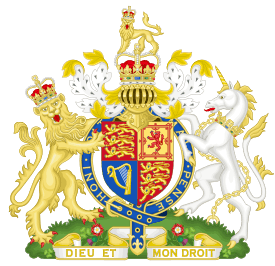
.svg.png)

